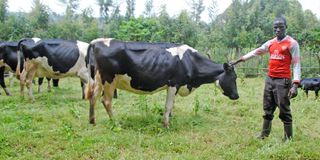Vet on call: Find out the livestock diseases in your area

What you need to know:
- The disease is called malignant catarrhal fever (MCF) and was caused by wildebeests when they gave birth in his pastures.
- Sheep are also known to be carriers of a second type of the MCF virus called the sheep strain. In temperate countries, cattle have been known to get MCF from contact with sheep.
- During pregnancy, the virus multiplies in the foetal membranes and is shed off into the environment when the wildebeest cow calves down.
- Veterinary scientists continue to research on the disease. Fortunately, changes in land use, increasing confinement of wildebeests in fenced-off game parks and enhanced knowledge of control of the disease through fencing of pasturelands may provide a solution to the MCF problem faster than scientific research towards a vaccine or cure.
You often see people with black spots on their faces and hands and they never complain about them.
In many cases, these are viruses called papilloma but they do not normally cause any serious problem to the host. You may also find the papillomas on livestock and pets.
When I am presented with papilomas, otherwise called warts, in pets or livestock, I first determine if they are a danger to the animal or they are just harmlessly trying to survive.
If they cause no obvious problems such as bleeding, bacterial infection or fast invasive growth, I do not intervene.
Very often, the body has a way of dealing with them by controlling their growth and spread or developing antibodies and clearing the warts off.
The presence of micro-organisms in the environment such as viruses and bacteria is one of the presented theories of how the current Covid-19 pandemic came into being.
It is postulated to have emanated from human interactions with bats and snakes in China.
Scientists are not yet clear on the origin of this dreaded virus, which has put the world in socio-economic chaos and fear of unprecedented proportions.
Locally, we have viruses that stay quiet under normal circumstances but situations often arise when the apparently dormant micro-organisms show their might in livestock.
A month ago, Kamau a loyal client, reported his cattle had died in large numbers in Narok. I recalled a few weeks earlier he had shown me his enviable herd of beef cattle and Doper sheep.
HEAVY EYE DISCHARGE
I remember cautioning him to check from the local vet and cattle farmers the diseases prevalent in the area. He had purchased a large piece of land where he planned to raise cattle, sheep and goats commercially for meat.
He said his cattle had started having heavy eye discharge, which later turned pus-like. They had wounds on the muzzle and tongue and could not eat. Lymph nodes were swollen and some animals had bloody diarrhoea.
The animals preferred to stand against the wind direction. He had already lost 20 cattle of various ages from his 200 animals.
He wanted to know what the disease could be and whether it could be treated or prevented. “Will the disease kill all my animals?” he wondered. I asked him what he had been told by his local animal health service providers.
Kamau said he had been informed the disease is called malignant catarrhal fever (MCF) and was caused by wildebeests when they gave birth in his pastures.
It had no specific treatment but animals could be treated for the disease symptoms observed and to prevent bacterial infection.
I concurred with the diagnosis and the advice offered to the farmer. On further prodding, Kamau told me he had fenced off his farm but some wildebeests had broken through and spent three days there.
Three had calved down on the farm and mixed with his cattle before being chased away by his workers.
WILDEBEEST INVASION
The history of the disease outbreak on Kamau’s farm confirmed the MCF diagnosis. Wildebeests are carriers of the MCF virus and it does not appear to cause disease in the animals.
During pregnancy, the virus multiplies in the foetal membranes and is shed off into the environment when the wildebeest cow calves down.
When cattle feed on the contaminated pasture, they inhale or ingest the virus. The virus is highly infective to cattle. It causes high temperature and the other signs seen with Kamau’s cattle.
Formation of pussy discharge in the nose makes breathing difficult. That is why infected cattle prefer to stand against the wind in an attempt to passively ease breathing. Most infected cattle die.
However, the disease often does not infect all the animals in a large herd. MCF is not known to infect humans.
The good thing with the MCF virus is that it has a short lifespan in hot dry conditions like those of Narok and Kajiado. This explains why the disease is not very common in those areas despite the presence of numerous wildebeests.
Infected cattle may infect other cattle through licking of the muzzle and inhalation of the virus but the cattle to cattle infection is not very efficient. This further explains the low rate of infection of cattle in a herd.
There is no known cure for MCF. Infected cattle are treated with antibiotics to prevent opportunistic bacterial infections. They are also given anti-inflammatories to reduce pain and tissue damage.
CONTACT WIT SHEEP
Scientists have found it difficult to develop a vaccine for the virus despite numerous researches. The disease is prevented by avoiding contact of cattle with infectious material especially foetal membranes and fluids from calving wildebeests.
Cattle pastures should be properly fenced off to prevent contact with wildebeests. The animals should immediately be expelled from the cattle pastures if they breach the fence.
Cows should be quickly removed from areas where wildebeests have calved.
Sheep are also known to be carriers of a second type of the MCF virus called the sheep strain. In temperate countries, cattle have been known to get MCF from contact with sheep.
The disease and the virus are very closely related to the wildebeest virus strain. The sheep strain has, however, not been found to have caused MCF in Kenyan cattle.
MCF in Kenya has mainly been documented in Machakos, Kajiado and Narok and attributed to wildebeests’ calving incidents on cattle pastures.
Veterinary scientists continue to research on the disease. Fortunately, changes in land use, increasing confinement of wildebeests in fenced-off game parks and enhanced knowledge of control of the disease through fencing of pasturelands may provide a solution to the MCF problem faster than scientific research towards a vaccine or cure.


